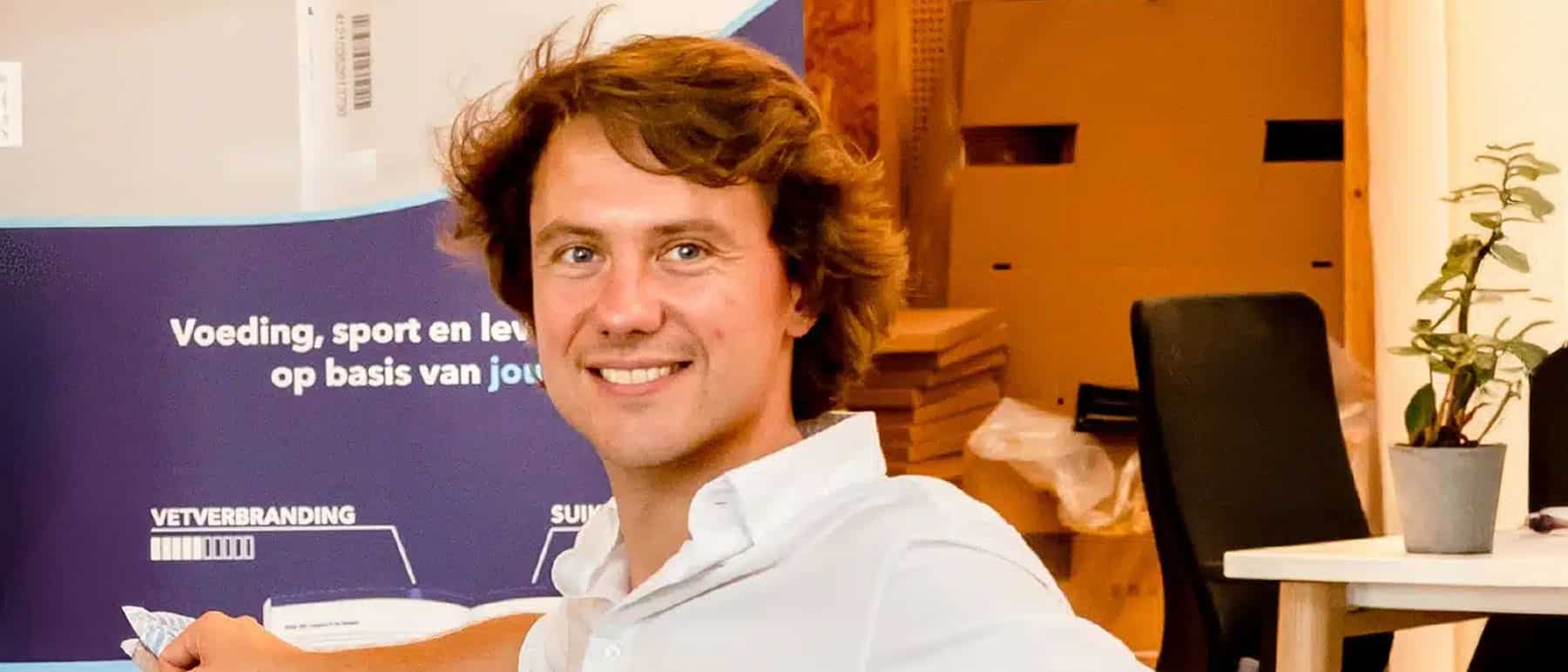From Ice Hockey to Warm Client Conversations in Professional Services
I spoke with him from a shared DNA: sport as the foundation for who we are as business partners. My own journey began in 1976, as an 11-year-old boy with Olympic dreams inspired by Ivo Van Damme’s achievements.
Although I never became an Olympic champion, intensive sport shaped my career and mindset. It is probably no coincidence that my motto today is: “If better is possible, good is not good enough.”
The leap from the runway
“I stopped professional hockey in 2020 and started my own coaching practice,” Lasse explained. “In the beginning, it was uncertain. I didn’t have a large network outside the sports world, but I had my reputation and the skills I had built.”
His first clients came through warm contacts and from people who valued him as a person, not only as a former athlete. Authenticity proved decisive. This emphasis on trust and relationship is essential in professional services like business development, leadership coaching, and strategic advisory—fields where no law mandates our engagement.
Unlike regulated sectors like accountancy or audit, our work is entirely discretionary. Morgan and Hunt (1994) show that trust and relationship drive long-term client loyalty, surpassing even price or product.
Navigating complex airspace: one person, big ambitions
“The hardest thing as a solo entrepreneur,” says Lasse, “is doing everything yourself. Sales, administration, coaching, invoicing—each day only has 24 hours, and you want to maintain your standards.”
I immediately recognize that tension. In non-mandatory professional services, you have big ambitions but limited resources. You must choose: where do you invest your energy?
At Add Business, the principle is clear: focus on clients with the right DNA and dare to say no to those who don’t fit.
Lasse adds: “Nick Rubin from Nordic Business Forum said: you don’t have to know everything before you start. That gave me peace. Learning is part of the process.” Humility combined with perseverance is what elite sport teaches us. You lose more often than you win, but progress depends on showing up.
From cold contacts to warm conversations
I asked Lasse how he finds new clients today. His answer was clear:
“First and foremost, I’m more active in meeting people. That’s why I was at the Nordic Business Forum. I need to go where new people are; otherwise, I’ll never meet them.”
He also reactivates his existing network: “I call former clients and ask: is there something we can do together? Even one new introduction can make a difference.”
No cold campaigns—only personal meetings, lunches, and warm introductions. Bhatia and Yetton (2020) confirm that in professional services, personalized outreach and referrals deliver significantly higher conversion rates. In fields where no one feels an urgent need for our help, building trust and visibility is the essence of business development.
DNA-match: recognizing the right client
“I look for clients with a learning mindset,” says Lasse. “People open to growth and change. I avoid working for clients who just want someone to come and shout at their team. That’s not my approach.”
Both of us know not every potential client fits our philosophy—and saying ‘no’ to mismatches proves as important as saying ‘yes’ to the right ones. In non-mandatory professional services, this selectivity becomes a necessity.
Research shows that focusing on ideal clients—rather than mass marketing—yields the strongest long-term results.
Sport as metaphor: teamwork and connection
Lasse learned on the ice what collaboration really means: “You don’t have to be best friends, but you can respect and value people for what they bring.”
In business development, endurance, self-discipline, and resilience are just as critical. Nahapiet and Ghoshal (1998) describe this as relational capital: the ability to create value through respectful, professional connections, across differences.
This is invaluable in professional services where engagement is always a choice, never an obligation. Building bridges is what grows a market when demand must be created, not fulfilled.
Cultural intelligence: Finland, Belgium, and the power of modesty
We also talked about cultural differences. Lasse described how Finns often doubt their ability to succeed abroad—they’re modest, sometimes too much so. In Flanders, we see the same paradox: pride mixed with constant self-questioning. By working together, we transform modesty into confidence.
He gives me insight into Finnish business culture—honesty and teamwork—while I help him navigate the Belgian ecosystem. Together we build Networks Beyond Borders: human bridges between economies.
Earley and Ang (2003) identify this capacity to work across cultures as a real competitive advantage—especially in professional services with global, voluntary clients.
Helping each other as solos: why 1+1=3
We discovered that solo entrepreneurs can go further together. Not by selling for each other, but by sharing networks and supporting mutual growth.
Granovetter (1973) argues that weak ties—distant or secondary contacts—are vital for unlocking new opportunities. For professionals whose services no client truly ‘needs’ until they choose to, collaborative ecosystems multiply your reach and credibility.
Lessons from this conversation with Lasse
- Authenticity trumps credentials. Clients choose people who inspire confidence and growth.
- Warm relationships beat cold outreach. Events, introductions, and networks create fertile ground.
- DNA-match matters more than volume. Serving clients who truly fit brings satisfaction, even if the pool is smaller.
- Patience and perseverance are essential. Progress is slow, but real.
- Demand must be created, not waited for. In a world where our services are never ‘required,’ visibility, credibility, and relationship-building are the core of business development.
Conclusion: charting a course with sport in the DNA
From Olympic dreams to ice hockey careers, sport shapes both mindset and method. In discretionary professional services, nobody is waiting for us, and that makes our work both challenging and rewarding. Succeeding here depends on creating genuine demand: through connection, insight, and continuous proactive engagement—everything sport has taught us.
If better is possible, good is not good enough.
References
- Bhatia, Amit, and Philip Yetton. 2020. “Personalization in B2B Sales Outreach: Effects on Engagement and Response Rates.” Journal of Business Research 116: 375–86.
- Earley, P. Christopher, and Soon Ang. 2003. Cultural Intelligence: Individual Interactions Across Cultures. Stanford, CA: Stanford University Press.
- Granovetter, Mark S. 1973. “The Strength of Weak Ties.” American Journal of Sociology 78 (6): 1360–80.
- Morgan, Robert M., and Shelby D. Hunt. 1994. “The Commitment-Trust Theory of Relationship Marketing.” Journal of Marketing 58 (3): 20–38.
- Nahapiet, Janine, and Sumantra Ghoshal. 1998. “Social Capital, Intellectual Capital, and the Organizational Advantage.” Academy of Management Review 23 (2): 242–66.
Ready to land in Belgium?
Discover how your company can land smoothly in Belgium — with a co-pilot who knows the terrain, the networks, and the fastest route to success.
Art, Craftsmanship and Entrepreneurship: Connecting Generations
In the halls of KMSKA, you walk through the stories of entrepreneurs written in paint, sweat and vision. Each work is a chapter in the great book of transfer and renewal. Art isn’t just a backdrop, it’s a cockpit. Rubens, Smits, Ensor—names that move systems and generations.
Rubens: Master of Scaling and System
Picture Rubens in 17th-century Antwerp. Not a solitary figure in an attic, but a director in the heart of his workshop. His studio hums like a production house. Helpers mix pigments, young talent emerges. Rubens paints the finishing touch. Quality is never diluted. Everything revolves around control, reputation, and transmission. His palace functions as cockpit and as branding. Luxurious ultramarine? Not just colour, but statement. The market is segmented: exclusive masterpieces, solid team works, accessible sketches. Even his will breathes strategy. Art is only sold when successors hit the required level. Legacy remains in the cockpit. After his death, his system lives on.
Smits: Reflection and Rebellion
Smits grows up in a decorative family business. But tradition for him isn’t a destination, it’s a launchpad. He travels the world, collects layer painting technique, and returns with a new perspective. His portraits are direct: no sugarcoating, real light and character. Clients face their true selves—a business lesson in authenticity and positioning. In his later years, Smits changes course: bold light masses, more courage. Evolution rooted in respect for the craft, never stuck in fossilized repetition.
Ensor: Mask, Marketing and Provocation
Ensor starts among the masks of home and carnival. He transforms them into weapons of critique. Behind every mask is a story: identity, hypocrisy, fear. His surrealism provokes juries and the public. Rejection? He flips it into visibility. First shut out, then discovered by collectors, eventually embraced in niche markets. His provocation isn’t coincidence—it’s commercial cunning. The cycle of tradition, confrontation and transfer repeats itself.
Art and Capital: The City’s Dance
Bruges, Antwerp, Brussels, Ghent. Each city draws art, but only when capital and infrastructure align. Artists follow money, elite, networks. The rise of creative hubs in the renaissance proves business and art aren’t separate worlds. Art only matters once it’s allowed to play in the economic cockpit.
Managing Generations: Cockpit Thinking Avant la Lettre
Rubens, Smits, Ensor don’t build sacred traditions—they manage dynamic systems. Respect for the past, provocation against the present, readiness for the future. Their methods are sharp, sometimes ruthless: talent is selected, opportunities shared, knowledge transferred. When generations truly collaborate, resilience emerges. You don’t build a museum, but a flying cockpit.
Craftsmanship and Provocation as Premium Strategy
Innovation lives not only in modern techniques, but in the guts to use and break tradition strategically. Those who use the best pigments and dare to confront set the market. Art and entrepreneurship are each other’s catalyst. You’re visible because you’re sharp, not because you keep repeating.
Segmentation, No Dilution
Rubens set the standard for portfolio management without anyone realizing. He offered multiple lines for different target groups, never losing his top level. His model still inspires design, fashion and luxury brands today. Smart scaling isn’t about volume, but about protecting—and broadening—quality.
The story doesn’t stop here. In every cockpit, in every creative company, the dynamic of these artists lives on. Connecting generations is a craft. Art and entrepreneurship mirror each other. Dare to steer, to confront, and to build legacy.
The Flywheel of Digital Health: How Biometriq Builds an Ecosystem
How much courage do you need to slow down before you speed up? That question lingered after my conversation with Pieter Josson, co-founder and CEO of Biometriq. What he and his team do may seem obvious at first—helping dietitians with technology. But beneath that lies a rare combination of strategic discipline, ecosystem thinking, and the bravery to make different choices than the crowd.
From Analog to Digital
In 2019, Pieter Josson and Tijs Engelreist started Biometriq. They saw what many missed—a crucial health profession still working as if it were 30 years ago. Dietitians drowned in administration, lacked data insight, and could barely measure their impact.
Pieter: “It’s still an underdigitized profession. We fully invest in integrating the latest technologies into our platform, so dietitians can work more efficiently.”
The platform integrates DNA analyses, wearables, sensors, and questionnaires into one coherent picture to help professionals provide personalized advice. Today, over 330 dietitians in Belgium and the Netherlands use Biometriq, together guiding about 24,000 people.
Reflection
New technology only breaks through to the masses when it is integrated into existing routines. Rogers (2003) calls this the leap from early adopters to the early majority. Biometriq proves how crucial this connection is—the success lies not just in data and algorithms, but especially in how dietitians can use them in daily practice.
The Strategic Choice That Changed Everything
Where many digital health startups chose B2C, Biometriq consciously went B2B.
Pieter: “Many companies in digital health take a B2C approach from the start. Our luck was that we didn’t do that. That gave us a solid base.”
That choice provided stable income and time to refine the product. A simple database query yielded a sharp datapoint: 92% of end users are women. Such insights force segmentation and choices reaching beyond the first ring of customers.
Reflection
Christensen (1997) states that successful innovation starts from the job-to-be-done. Biometriq illustrates this: it’s not about software per se, but about making the dietitian’s job easier and more valuable. The insight that 92% of end users are women highlights how important segmentation and a sharp ICP are for sustainable growth.
From First Customers to Ecosystem Leverage
The early years were about cold calling and one-on-one sales.
Pieter: “We come from a very manual one-on-one sales approach. Now, we’re switching to much more event-led growth.”
It became clear that dietitians are just one link in a larger system of companies, mutual funds, and insurers. Instead of growing one customer at a time, Biometriq sought leverage in that broader network.
Reflection
Blank (2013) emphasizes proving product-market fit before scaling systematically. Biometriq did this via intensive one-on-one sales, then shifted to scalable, event-led models. Their story also shows effectuation (Sarasvathy, 2001): by leveraging unexpected connections along the way, they discovered growth potential in the broader ecosystem.
From Platform to Ecosystem
The answer is a two-sided marketplace: software for practitioners and a digital gateway for organizations.
Pieter: “On one hand, we offer dietitians software to work efficiently. On the other, we build a marketplace enabling organizations to digitally refer employees or members to the ecosystem.”
This creates value for companies—well-being, motivation, employer branding—and for mutual funds and insurers—prevention and referral.
Reflection
Platforms are more than products; they are infrastructures enabling interactions. Hagiu & Wright (2015) describe how multisided platforms generate value by connecting distinct groups. Shapiro & Varian (1998) add that network effects strengthen as more parties join.
Pioneering between Chaos and Structure
Pieter Josson: “I think we made a billion mistakes.”
The European market is still “immature” compared to the U.S., where consolidation and acquisitions are further along. Precisely there, Pieter sees opportunities: those who build wisely now could become the core of an integrated ecosystem.
Reflection
Entrepreneurship often means balancing mistakes and progress. Sarasvathy (2001) calls this effectuation: starting with the means you have and learning by doing. Biometriq also shows how co-opetition (Brandenburger & Nalebuff, 1996) opens opportunities: partnering with potential competitors can speed up ecosystem growth.
The Flywheel in Action
With a recent funding round and a modest profit last year, momentum is building.
Pieter Josson: “We want to expand to France, but always with respect for the ecosystem.”
This is what Jim Collins calls the flywheel—consistent, reinforcing actions that accelerate over time.
Reflection
Collins (2001) shows that growth rarely comes from a single big leap, but from repeated efforts that build momentum together. Moore’s Crossing the Chasm (1991) confirms why Biometriq first anchored its niche before rolling out more broadly.
Lessons from the Biometriq Cockpit
- Slow down before you speed up. First understand, then build, then scale.
- Ecosystem over competition. Position yourself as a facilitator, not a replacer.
- Scale through segment focus. Start with a niche, then broaden.
- B2B as a bridge to B2C impact. Organizations often reach more end users than direct B2C channels.
Conclusion
Biometriq shows how entrepreneurs win their first customers through personal contact, perseverance, and validation—and then break through by thinking in ecosystems, making sharp choices, and leveraging network effects.
First conquer the niche, then leverage the network, and eventually set the flywheel in motion.
The story of Pieter Josson and Tijs Engelreist proves that sustainable growth emerges when you start small, learn from mistakes, and have the discipline to reach beyond your first network.
References
- Blank, S. (2013). The Four Steps to the Epiphany. K&S Ranch.
- Brandenburger, A.M., & Nalebuff, B.J. (1996). Co-opetition. Currency Doubleday.
- Christensen, C.M. (1997). The Innovator’s Dilemma. Harvard Business School Press.
- Collins, J. (2001). Good to Great. HarperBusiness.
- Edvardsson, B., Holmlund, M., & Strandvik, T. (2008). Industrial Marketing Management, 37(3), 339–350.
- Hagiu, A., & Wright, J. (2015). Multi-sided platforms. International Journal of Industrial Organization, 43, 162–174.
- Moore, G.A. (1991). Crossing the Chasm. HarperBusiness.
- Porter, M.E. (1985). Competitive Advantage. Free Press.
- Rogers, E.M. (2003). Diffusion of Innovations (5th ed.). Free Press.
- Sarasvathy, S.D. (2001). Academy of Management Review, 26(2), 243–263.
- Shapiro, C., & Varian, H.R. (1998). Information Rules. Harvard Business School Press.
From Tallinn to Antwerp: What Estonian companies need to know for a safe landing
In the cockpit of the NBB HUB this time: Pieter Poppelsdorf. For more than 4 years, he has been responsible for promoting Estonian investments within the Benelux, based in Amsterdam. He operates at the intersection of government and entrepreneurship, moving smoothly between policymakers, scale-ups, and investors. What makes Pieter unique is his linguistic talent and cultural compass. He speaks Dutch, Estonian, English, and French. This is not a luxury—it’s his essential work tool. From the Netherlands, he connects with Benelux stakeholders, building bridges between hyper-digital Estonia and the multi-layered decision-making of the Benelux.
He’s a networker with sharp insights and always to the point 😊.
“Forget the Estonian market. For Belgian investors, it’s all about the ecosystem and available talent. You don’t go to Estonia to sell to Estonians. You go for the environment, the network, the people.”
The route is not one-way
What Belgian companies are looking for in Estonia fundamentally differs from what Estonian companies seek in Belgium. That “flight direction” defines everything.
- Belgian companies move to Estonia for tech capacity, agility, and ecosystems.
- Estonian companies want to touch down in Belgium for market share, customer growth, and scaling.
It may seem trivial, but it’s crucial. Belgian companies don’t need to understand the Estonian customer. Estonian companies must understand the Belgian customer. And that’s where it can go wrong.
The challenge is cultural, not technical
Estonian companies are technically strong—brilliant, even. Commercially? That’s often the challenge. Pieter puts it directly:
“Estonians are product-oriented but sometimes lack marketing and sales knowledge. They build something and often think: this speaks for itself.”
In Belgium, nothing speaks for itself. Decision-makers want case studies, comparisons, and preferably a reference from someone they know. A CEO who says, “They really helped us,” opens more doors than ten technical demos.
Communication can also create friction. Pieter explains:
“Estonians expect you to follow up. For Belgians, that can be difficult. In Belgium, if you request a meeting, we expect you to also do the follow-up.”
At the same time, Estonians find Belgian decision-making slow, ambiguous, and tiring. What they perceive as indecision is, for Belgian companies, simply getting everyone on board. It requires guidance and translation—not just of language, but of pace and expectations.
Why Rethink does land in Belgium
The difference between stumbling and landing? DNA and preparation.
Rethink, a digital service design and innovation agency from Tallinn, takes a fundamentally different approach. They follow the entire NBB HUB DNA trajectory. Not a quick pitch, but a thorough process around positioning, value proposition, and cultural translation.
We align their DNA with the Belgian ecosystem, with clear entry points in education and the public sector.
“The quality of the landing depends a lot on the precision of the preparation. Rethink realizes you need to know the landscape before you land in it.”
Belgium a country?
A frequently underestimated obstacle. Companies see Belgium—and by extension the Benelux—as one market.
Pieter laughs:
“The Benelux isn’t a country. Belgium alone is three markets: Flanders, Wallonia, Brussels. Each with different rules, networks, and expectations. And that applies to the Netherlands too.”
That’s why local guidance isn’t a luxury. It’s the only way to avoid months lost to misunderstandings, cold contacts, and false assumptions. The NBB HUB isn’t an intermediary, but a navigation partner. Not “we’ll do it for you,” but “we’ll teach you to land as it works here.”
Ready to land in Belgium?
Discover how your company can land smoothly in Belgium — with a co-pilot who knows the terrain, the networks, and the fastest route to success.
In the Cockpit with Rémy: From Tennis Court to Phone Line
Before Rémy Van Haver started his sales career, he was on the tennis court. At sixteen, he coached adults. That was not obvious. “They looked at me as if I was their son. Until I stepped onto the court, played ten points, and won. Then I got respect,” he says. “That moment taught me that if you want to be convincing, you have to show it yourself first. Don’t talk, just do.”
Today, Rémy applies this principle as a sales coach at “Sales with Insight.” His career took him from Pepperminds, where he led a team of ninety students, to Salesforce in Dublin, and then to coaching and training in Belgium.
The Rotten Apple and the Power of Patience
Rémy likes to compare client development to a fruit bowl. “Everyone has their thoughts: finance, HR, sales, but often there’s no apple named ‘coaching’ yet. By staying visible via videos, LinkedIn, or a phone call, you place that apple there yourself. At first they ignore it, but over time it starts to ferment. You influence their mindset.”
Research shows prospects need multiple touchpoints before taking action (Kahneman & Tversky, 1979). That captures his approach: no shortcuts, but rhythm and presence.
“You don’t have to convince anyone in a single conversation. You just have to show up often enough not to be forgotten.”
From Video to Connection
His favorite medium is video—not commercials, but short, spontaneous messages with humor.
“Recently I was literally in bed with a cap on because I had a cold. But it worked. People felt it was real.”
He recalls a specific video to a CEO: “I just said: I’m not applying for a job, but I saw you offer training. Do you do that internally or externally? No script, just human. Four videos, four responses. That’s proof enough.”
Research confirms that multichannel prospecting — video, LinkedIn, and calling — significantly increases engagement (Sopro, 2025). Rémy’s approach combines reach with reliability.
Cold Calling Isn’t Dead, It’s Got Smarter
“At Salesforce, I did deep freeze calling,” he says. “Lists of fifty companies a day, five contacts per company, just calling. It worked because you had the Salesforce name behind you. But now I do it differently. I never call without a reason.”
He calls his method proactive calling: first connect on LinkedIn, then a video, then the phone. “You’re no longer a stranger. It’s not a cold call but a warm conversation.”
EQ Off, Perseverance On
“People with lots of empathy often stop too early,” he says. “They feel the other person is busy and think: I’ll leave them alone. But sales sometimes requires you to park your EQ for a moment.”
His golden rule: if someone says they’ll call back and doesn’t, that’s no reason to stop.
“Call again on Thursday. Send a message on Friday. Call again on Tuesday. Not to push, but to show you mean it.”
Studies show it takes around eight attempts to reach a prospect, and eighty percent of prospects say “no” four times before they say “yes” (Resimpli, 2025). Rémy’s strength is knowing this—then persevering.
The Generation Gap and the Power of a Meme
“My generation communicates differently,” he says. “We send voice notes, memes, or just a ‘haha’ without context. It may seem airy, but it connects.”
He also uses humor in prospecting. “After three days without a reply I sometimes send a meme of Pablo Escobar staring into space. No text. Usually I get a laugh and a reply. It doesn’t work for everyone, but when it fits, it’s gold.”
Research shows Gen Z doesn’t shy away from calling. While 61% prefer text for personal contact, 71% say calling is still the fastest, most effective way to solve business problems (McKinsey, 2024).
LinkedIn as a Training Ground
Rémy posts weekly on LinkedIn—not just for visibility, but to train rhythm.
“At first, I let AI write my content. But it felt cold. Now I type everything myself, from experience. It’s more human and my reach grows.”
Recently he received a message: “Hey, saw your post — funny, by the way — can we talk?” Not a cold lead, but a warm opening.
In an era of AI content, audiences crave authenticity. By sharing human stories and vulnerability, Rémy builds trust even before the first conversation.
The Power of Coaching and Fun
What does he love most? “Helping people rediscover the fun in prospecting. Not fear, but play. We call together, laugh at mistakes, improve along the way. Sales isn’t an exam. It’s a game you learn from in every call.”
The link with tennis is obvious. “I don’t teach people how to win, but how to play better. Rally after rally, point after point. That’s also true for developing new customers.”
What We Can Learn From Rémy
- The phone is alive if you use it smartly. Gen Z does call — with context. First connect, then call.
- Use multiple channels. Video, LinkedIn, and calling reinforce each other. Combine for faster recognition and recall.
- Perseverance beats perfect timing. Most sellers stop too soon. Relevant, repeated presence makes the difference.
- Authenticity beats perfection. A cap, a cough, a smile — it makes you human. Do what suits you. That builds trust and joy.
- See sales as a game, not a test. Every call is practice. Mistakes happen. Those who learn to play, keep growing.
- Blend old and new. Modern tools help, but the core is human contact, listening, and persistence.
Conclusion
Rémy Van Haver embodies the new generation of sales professionals rewriting the rules without abandoning the foundation.
PS: If you ever get a Pablo Escobar meme in your inbox, you’ll know: you’re in Rémy’s fruit bowl. And that’s a good sign.
References
- Abstraktmg. (2025). What You Need to Know About Multi Channel Prospecting. abstraktmg.com
- British Council. (2024). Gen Z in the Workplace… corporate.britishcouncil.org
- Cognism. (2024). The State of Cold Calling in 2024. cognism.com
- Kahneman, D., & Tversky, A. (1979). Prospect Theory…
- McKinsey (2024). Why Your Kids Aren’t Calling You… mckinsey.com
- Resimpli. (2025). 65 Cold Calling Statistics… resimpli.com
- Salesmate. (2024). Is Cold Calling Dead… salesmate.io
- Sopro. (2025). The Ultimate Guide to Multi Channel Prospecting. sopro.io





